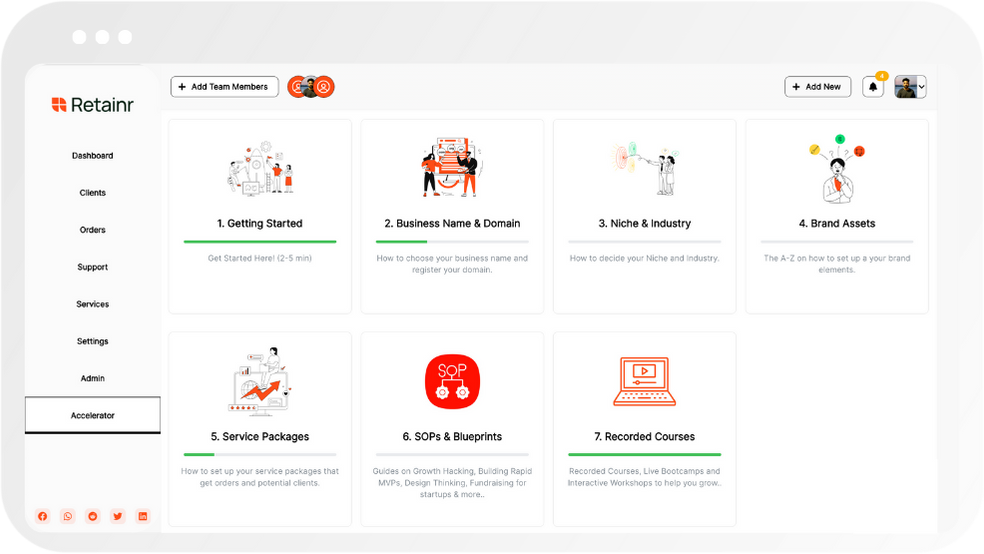
How to Efficiently Allocate Resources for Your Project
Build with Retainr
Sell your products and services, manage clients, orders, payments, automate your client onboarding and management with your own branded web application.
Get Started1. What are the strategies for efficient resource allocation in a project?
Identifying Resources and Prioritizing
In order to ensure efficient resource allocation, you must first clearly identify the resources required for the project and prioritize them based on their importance. Resources may include manpower, equipment, software, workspace and financial resources. You can organize this data using a simple table like so:
| Resource category | Resources included |
|---|---|
| Manpower | Project manager, software engineers, data analysts |
| Equipment | Computers, server space, testing tools |
| Software | Project management software, coding platforms |
| Workspace | Office space, remote working tools |
| Financial Resources | Budget for procurement, salaries, utility bills |
Creating a Resource Allocation Plan
Once all resources have been identified and prioritized, the next step involves creating a resource allocation plan. This plan should take into consideration the project timeline and important milestones. All resources should be allocated where they are needed the most and at the right time to ensure maximum efficiency. Tools such as Gantt charts and resource histograms can be used to visualize this plan and share it with the team.
Monitoring and Adjusting Resources
After resource allocation, ongoing monitoring is crucial to ensure resources are being used as planned and to detect any inefficiencies early. An important part of this monitoring involves keeping a close eye on resource utilization rates and making adjustments as necessary. If a resource is being underutilized, it may be reassigned to another area where it can be put to better use. On the other hand, if a resource is overburdened, this could be a sign that additional resources are needed to prevent burnout and maintain productivity.
2. How does resource allocation impact project management?
Impact of Resource Allocation on Project Management: Success and Risks
Allocating resources efficiently can significantly impact the success of project management. It contributes to setting realistic project objectives, proper scheduling, cost control, and significantly determines the project's end date. Conversely, inefficient allocation of resources can create multiple challenges, such as project delays, increased costs, and reduced profitability.
- Optimization of Resources: Resource allocation helps to handle the resources more efficiently, thus preventing wastage and bottlenecks.
- Improved Scheduling: Allocation of resources enables project managers to plan the project schedule effectively, ensuring tasks are completed within the timeline.
- Control of Costs: Keeping track of resource allocation, project managers can keep an eye on the project costs, reducing the risk of overspending.
Crucial Elements of Resource Allocation in Project Management
For resource allocation to be effective, it must be matched with project demands at every phase. The key elements of it are resource availability, their capability, cost of the resource, and workload. The table below describes these elements:
| Elements | Description |
|---|---|
| Resource Availability | Resources available for the project, including human resources, financial resources, and material resources. |
| Capability | The skills, expertise, and proficiency of the resources, often crucial in task assignment. |
| Cost | Project budget against the cost of each resource. This component is vital during planning for cost control. |
| Workload | The amount of work assigned to each resource. Effective resource allocation aims to balance the workload for resource optimization. |
Consequences of Poor Resource Allocation
Poor resource allocation can lead to numerous problems in project management. Failures in the allocation process can result in project overruns, inefficiencies, and potential termination of projects. A few consequences include:
- Increased costs: Resources cost money, and any misuse can directly affect the project’s budget.
- Delayed completion: Poor allocation can extend the timeline of the project as resources might not be available when required.
- Decreased quality: Allocating unsuitable resources can impact the quality of the project outputs.
3. What tools can help in resource allocation for a project?
Software Tools for Resource Allocation
Implementing the right tools can significantly simplify the process of resource allocation. For instance, Project Management Software like Microsoft Projects, Trello, and Asana aid in visually organizing and scheduling tasks while assessing the resources required for each task. Enterprise Resource Planning (ERP) Software such as SAP and Oracle offer solutions for managing different resources like human resources, financials, and supply chain. Moreover, Time-tracking Tools such as TimeCamp and Harvest are used to accurately measure the time resources spent on specific tasks, hence providing data for future resource allocation planning.
Advantages of Using Tools for Resource Allocation
These software tools offer numerous benefits in resource allocation. They help in improving transparency, which aids all stakeholders in staying updated on the status of the project. They also assist in enhancing efficiency by optimizing resource allocation hence limiting wastage. Additionally, they contribute to boosting productivity by automating certain manual tasks hence freeing up personnel to focus on other crucial areas of the project.
A Comparison Table of Resource Allocation Tools
| Tool | Type | Key Features |
|---|---|---|
| Microsoft Projects | Project Management Software | Task scheduling, Gantt charts, reporting |
| SAP | ERP Software | Financial management, HR management, Supply chain management |
| TimeCamp | Time-Tracking Tool | Automatic time tracking, detailed reporting, billable hours tracking |
4. How can you avoid overallocation or under allocation of resources in a project?
Avoiding Overallocation and Underallocation of Resources
Overallocation and underallocation of resources in a project can drastically impact the outcome and its success. Therefore, it is crucial to strike an optimal balance. One of the primary ways to avoid overallocation or underallocation of resources is by having an effective project management software in place. Ideally, this software should provide real-time updates on resource usage, enabling adjustments as needed.
Apart from employing a good project management software, three pertinent methods can be employed. Firstly, Plan ahead. Before the project starts, define all the work that needs to be done, and estimate the resources needed for each task. This prevents last-minute rush, which may lead to overallocation. Secondly, Monitor resource usage. By having record checks at regular intervals, you can identify and rectify any instances of overallocation or underallocation. Lastly, Communicate effectively. Ensure that all team members are aware of the resource allocation plan and can notify you of any concerns that might lead to overallocation or underallocation.
| Method | Description |
|---|---|
| Plan ahead | Defining and estimating the work and resources beforehand |
| Monitor resource usage | Regular check-ins to identify and rectify any misallocations |
| Communicate effectively | Ensuring that the team is aware of the resource allocation plan and can raise any concerns |
In conclusion, avoiding overallocation or underallocation of resources involves effective planning and monitoring, harnessing technology to streamline the process, and promoting clear and effective communication among all stakeholders. Through this balanced approach, your project stands a better chance at succeeding and achieving its goals.
5. How should the resource allocation be adjusted during the life cycle of a project?
Adjustment of Resource Allocation During Project Life Cycle
Resource allocation during a project's lifecycle is a dynamic process. Over time, project needs may change, influencing the kind of resources required, the quantity, and the time needed. This necessitates regular adjustment of resource allocation based on several factors.
Key Factors Influencing Resource Allocation Adjustment
- Resource Availability: If a resource becomes unavailable due to unforeseen circumstances, you will need to find a replacement. This could mean substituting a specific person or a material, depending on what's unavailable.
- Change in Project Scope: If the scope of your project expands or contracts, this will directly impact the resources you require. In such cases, your resource allocation plan should be adjusted accordingly.
- Delays: If there are delays in the project timeline, you may find that changes need to be made to your resource allocation. For example, you may need to increase the number of workers assigned to a task to catch up.
Suggested Resource Allocation Adjustment Matrix
| Factors | Adjustment | Example |
|---|---|---|
| Resource Availability | Replace Unavailable Resources | Substitute missing material with an available one or assign another person to a role if someone falls gravely ill |
| Change in Project Scope | Adjust Based On New Scope | Increase the number of skilled mechanists if the scope of work demands more mechanical work |
| Delays | Reallocate to Make Up for Lost Time | If a task falls behind, assign more workers to it to speed it up |
6. How does efficient allocation of resources contribute to the success of a project?
Contribution of Efficient Resource Allocation to Project Success
Allocating resources efficiently is a crucial factor for the success of a project. It directly impacts the performance, productivity, and profitability of a project in several ways:
- Cost Efficiency: Resource allocation helps in reducing unnecessary costs. By ensuring that resources are used optimally and not wasted, financial resources can be channeled where they are most needed.
- Time Management: With proper planning, resources can be allocated in such a way that ensures tasks are completed within the project's timeline. This results in fewer delays and increased productivity.
- Risk Management: Efficient allocation also equates to less risk. Understanding the capacity of your staff allows you to avoid overloading them, thus reducing the risk of burnout or missed deadlines.
The following table provides an example of how efficient resource allocation can affect different areas of a project:
| Area | Without Efficient Resource Allocation | With Efficient Resource Allocation |
|---|---|---|
| Cost | Higher expenditure due to waste | Lower expenditure due to improved efficiency |
| Time | More likely to face delays | Tasks are more likely to be completed on schedule |
| Risk | Higher risk of missed deadlines | Lower risk due to better staff capacity management |
In conclusion, resource allocation, when efficiently managed, brings about a substantial positive effect on your project's success by reducing risks, managing time, and ensuring cost efficiency. A project manager must strategically allocate resources to ensure the most efficient use of each resource, ensuring the project's success.
7. What are the challenges faced during resource allocation in project management?
Common Challenges in Resource Allocation
Resource allocation plays a pivotal role in project management. However, it also presents several complications that decision-makers must navigate meticulously. Following are some of the recurrent challenges:
- Resource Scarcity: There may not be enough personnel or technological resources to execute the project as initially planned.
- Unexpected Changes: Project plans may change hastily, and the assigned resources may not be adaptable enough to accommodate these changes.
- Resource Overallocation: At times, resources could be reserved excessively for certain tasks while others may be shortchanged, creating imbalances.
Navigating Through Resource Allocation Challenges
Addressing these challenges promptly and smartly is crucial for successful project execution. Decision-makers can stick to the following principles and steps when facing resource allocation predicaments:
- Consistent Communication: Keep the lines of communication open to handle sudden changes, and ensure all team members stay informed.
- Using Technology: Employ project management software that helps in resource allocation and can be easily adjusted during the project's lifecycle.
- Plan for Scarcities: Formulate a contingency plan for the unexpected occurrences of resource scarcity or overutilization.
Overview of the Challenges and Solutions
| Challenges | Solutions |
|---|---|
| Resource Scarcity | Plan for Scarcities |
| Unexpected Changes | Consistent Communication |
| Resource Overallocation | Using Technology |
8. How can project managers estimate the resources needed for a project accurately?
Understanding the Nature of the Project
The first step in estimating the resources required for a project accurately is to fully understand the project. This includes considering the scope, objectives, deliverables, and expected outcomes of the project.
- Scope: Project managers should have a clear idea of what the project is aiming to achieve. This includes the desired functionality and features.
- Objectives: These are the specific goals that the project aimed to accomplish.
- Deliverables: These are the specific outputs or products that the project should produce.
- Expected Outcomes: These are the anticipated benefits or results from the project.
Breakdown and Estimation Techniques
Effective estimation techniques can help project managers predict the necessary resources more accurately. One of these techniques is the Work Breakdown Structure (WBS), where the project is broken down into smaller, manageable tasks. Another common technique is the Use case Points method, where the functionality of the project is measured to anticipate the extent of resources required.
| Estimation Technique | Description |
|---|---|
| Work Breakdown Structure (WBS) | This includes breaking down the project into smaller tasks, with each task requiring a certain amount of resources. |
| Use case Points method | This method measures the functionality of the project to determine the extent of required resources. |
Risk Analysis and Contingency Planning
Every project has inherent risks that project managers need to consider when estimating resources. These risks can affect both the project's timeline and budget. As such, it's crucial to anticipate and account for these risks in the estimation process.
- Identify Risks: You should begin by identifying the potential risks that may affect your project.
- Assess Impact: Once the risks have been identified, you should then assess the potential impact of these risks on your project's resource requirements.
- Develop Contingency Plans: Based on your risk analysis, you can create contingency plans that provide buffers for your resource estimates.
9. How does efficient allocation of resources reduce project costs?
Understanding the Correlation Between Efficient Allocation of Resources and Reduced Project Cost
Efficient resource allocation reduces project cost significantly. Because every project comes with a certain budget, keeping control over costs is crucial for successful project management. Any wastage or unnecessary usage of resources can escalate costs and disturb the budget, potentially leading to project failure. On the other hand, efficient allocation of resources ensures that everything is utilized appropriately, thus reducing the overall project costs.
Ways through Which Efficient Allocation of Resources Reduces Project Cost
Below are several ways in which efficient allocation of resources can lead to decreased project costs:
- Eliminating Wastage: When resources are properly allocated, there is minimal or no wastage. This directly reduces costs associated with wasted resources.
- Reducing Overhead Costs: Overhead costs can be reduced by ensuring that resources such as staff and equipment are used optimally and not left idle.
- Effective Time Management: Time is a valuable resource in any project. When it's properly managed, the project is likely completed within schedule hence reducing costs associated with time overruns.
- Reducing the Need for Re-work: Efficient resource allocation can lead to better quality work thus reducing the need for rework and extra costs associated with it.
The Impact of Efficient Allocation of Resources on Different Project Cost Areas
| Project Cost Area | Impact of Efficient Resource Allocation |
|---|---|
| Material Costs | Minimized waste leads to lower costs. |
| Labor Costs | Optimal utilization reduces idle time and overpayment. |
| Overhead Costs | Efficient use of equipment reduces costs associated with idle machinery. |
| Time Costs | Timely completion of the project avoids additional costs. |
10. What is the role of risk management in resource allocation for a project?
Understanding the Role of Risk Management in Resource Allocation
The role of risk management in resource allocation for a project can’t be understated. In every project, there are always uncertainties and threats which might arise and impede progress. Risk management helps in identifying, analyzing, and managing these uncertainties to ensure that resources are allocated effectively without any unforeseen hindrances. It assists in limiting the negative impacts of such risks on the project and also in harnessing potential opportunities that may arise.
Key Functions of Risk Management in Resource Allocation
- Risk identification: One of the primary roles of risk management is identifying potential risks that can affect the resource allocation in a project. This process involves a comprehensive evaluation of both internal and external factors that may pose a threat to efficient resource distribution.
- Risk assessment: After the risks have been identified, risk assessment is carried out to determine the potential impact and probability of these risks. This helps in prioritizing the risks and determines which resources need to be allocated to deal with them.
- Risk control: This function involves developing strategies to minimize the impact of the identified risks on the project. For instance, contingency plans can be established that allocate resources for unexpected situations.
Sample Risk Management Table for Resource Allocation
A table can be used to illustrate this effectively. Below is an example:
| Risk | Probability | Impact | Resource Allocated |
|---|---|---|---|
| Team Member Illness | Medium | High | Additional Team Member |
| Software Failure | Low | High | Backup Software |
| Deadline extended | Low | Medium | Buffer Time |
Conclusion
Summary of Efficient Resource Allocation
Successful project management hinges on the aptitude to effectively allocate resources. Determine your project's needs, assign personnel based on skills, and maintain open communication. By streamlining these tasks, you can avoid overspending, missed deadlines, and mismanaged resources.
Introducing Retainr.io
A dynamic tool for efficient resource allocation is Retainr.io. This whitelabel software enables you to sell, manage clients, orders, and payments through a branded application. It is designed with an intuitive interface that simplifies tasks and increases productivity.
Benefits of Retainr.io
With Retainr.io, you can effectively identify your project's needs, assign suited team members, and maintain seamless communication. It ensures that resources are used appropriately and to their full potential, ultimately minimizing wastage and maximizing ROI. Visit Retainr.io to start managing your resources efficiently.
Boost Your Agency Growth
with Retainr Accelerator
Uncover secrets, strategies, and exclusive blueprints to take your agency's growth to the next level — from marketing insights to effective presentations and leveraging technology.

SOPs, Cheatsheets & Blueprints
Leverage 50+ SOPs (valued over $10K) offering practical guides, scripts, tools, hacks, templates, and cheat sheets to fast-track your startup's growth.
Connect with fellow entrepreneurs, share experiences, and get expert insights within our exclusive Facebook community.
.jpg)

Join a thriving community of growth hackers. Network, collaborate, and learn from like-minded entrepreneurs on a lifelong journey to success.

Gain expertise with recorded Courses, Live Bootcamps and interactive Workshops on topics like growth hacking, copywriting, no-code funnel building, performance marketing and more, taught by seasoned coaches & industry experts.

.jpg)

.jpeg)


